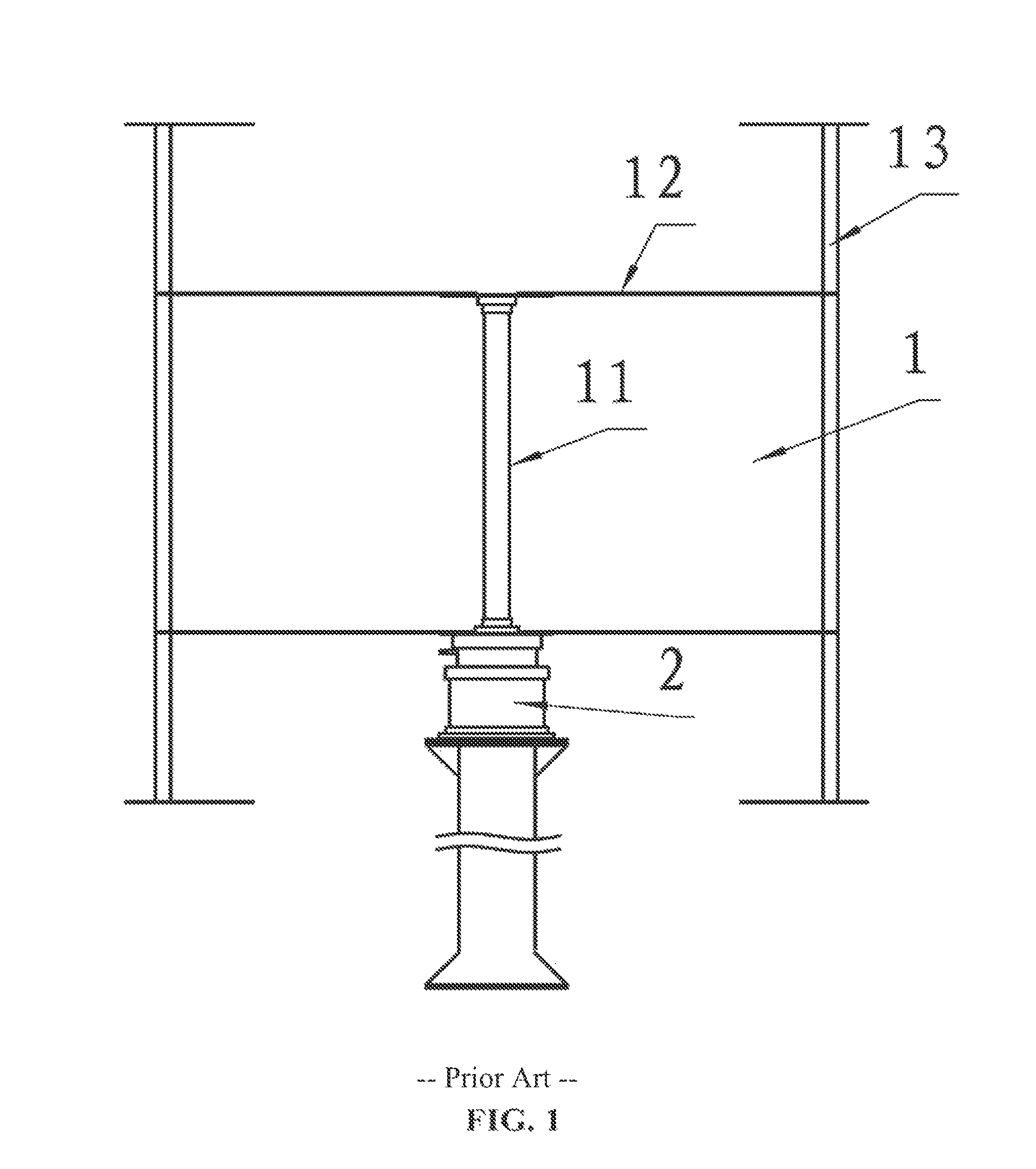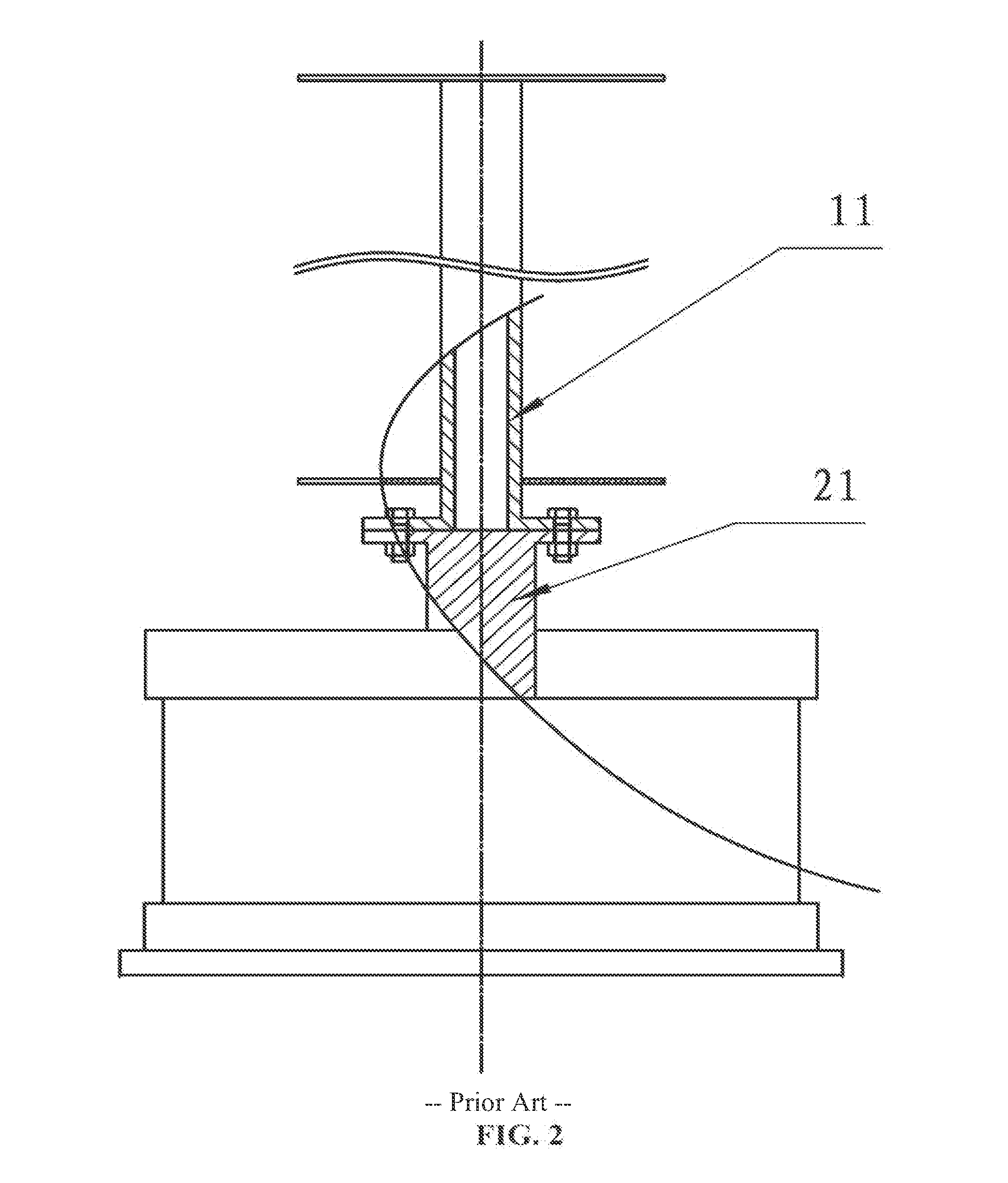Vertical axis wind turbine
a wind turbine technology, applied in the direction of electric generator control, renewable energy generation, greenhouse gas reduction, etc., can solve the problems of shortened service life, low assembly precision, increased weight and cost, etc., to increase the stability, reliability, and service life of the vertical axis wind turbine, and facilitate assembly on site
- Summary
- Abstract
- Description
- Claims
- Application Information
AI Technical Summary
Benefits of technology
Problems solved by technology
Method used
Image
Examples
example 1
[0035]A vertical axis wind turbine, as shown in FIG. 5, comprises: a vertical axis wind mill and a generator, wherein the vertical shaft 11 of the wind mill share the same shaft with the generator rotor shaft 21. The shaft is hollow inside to reduce weight. There is a chamfer 23 with inclination at the base of the hollow shaft, as shown in FIG. 9, to bear the wind mill's weight and to facilitate assembly. The lower bearing, an angular contact ball bearing with an inclination, is fixed on the pedestal to bear the wind mill's weight.
[0036]As shown in FIG. 6, assume each of the blades of the wind mill is H in length, based on mechanical analysis, the upper supporting arms and lower supporting arms preferably hold each blade at ¼ H at both ends, and assume the vertical shaft is L in length, the distance between the upper supporting arm and lower supporting arms is h, the L / h ratio is 1 / 1 to 3 / 2.
example 2
[0037]As shown in FIG. 7, a vertical axis wind turbine comprising: a vertical axis wind mill 1 and a generator 2, wherein the vertical shaft 11 is sleeved inside of the generator rotor shaft 21, and torque are conveyed by a key 45. At lease one of the upper bearing 41 or lower bearing is of an angular contact ball bearing, a roller bearing or a cylindrical roller bearing. The vertical shaft 11 and the generator rotor shaft 21 are rigid connected (tight fit or using structural adhesive) or clearance fit (tolerance 41 and lower bearing 42 to assume the wind mill's weight and alternating load, as shown in FIG. 8. The bottom of the vertical shaft 11 features chamfers with an inclination, as shown in FIG. 9, for the purpose of bearing the wind mill's weight and easy assembly.
[0038]The lower bearing 42 of the generator shaft adopts an angular contact ball bearing which has an inclination, and fixed on the generator's pedestal to bear the wind mill's weight; the upper bearing 41 may be of ...
example 3
[0039]A supporting-arms-connecting flange that facilitates on-site assembly as shown in FIG. 10. The flange 15 has a central hole to hold the vertical shaft, and a plurality of joints 14, which are of sleeve structure. The sleeve structure may be cylindrical, and connected with corresponding supporting arms by way of inserting or thread, greatly reducing the on-site workload. Pins or bolts 16 are used in the connecting part of the supporting arm and the flange joint for further reinforcement. The supporting arms may be hollow inside.
[0040]This invention simplifies the structure and increases the stability, reliability and services life of the vertical axis wind turbines, and by making on-site assembly easy and cutting on-site workload and cost, without undermining their wind resistance capability and safety, prompts wider application of vertical axis wind turbines.
PUM
 Login to View More
Login to View More Abstract
Description
Claims
Application Information
 Login to View More
Login to View More - R&D
- Intellectual Property
- Life Sciences
- Materials
- Tech Scout
- Unparalleled Data Quality
- Higher Quality Content
- 60% Fewer Hallucinations
Browse by: Latest US Patents, China's latest patents, Technical Efficacy Thesaurus, Application Domain, Technology Topic, Popular Technical Reports.
© 2025 PatSnap. All rights reserved.Legal|Privacy policy|Modern Slavery Act Transparency Statement|Sitemap|About US| Contact US: help@patsnap.com



